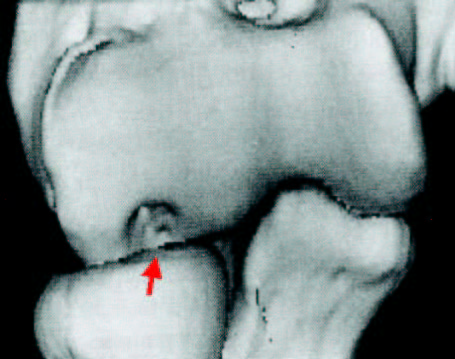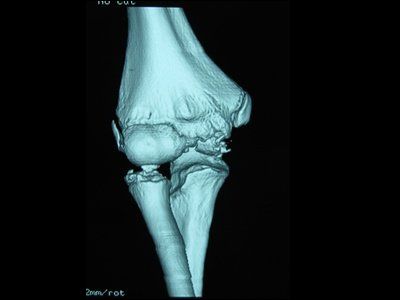Diagnosis of OCD
OCD can be diagnosed in a physical examination by a health professional, such as a physiotherapist or general practitioner. The examiner may observe the movement of the elbow while looking for any abnormalities such as;
· The patient is unable to fully straighten their elbow · Movement of the elbow causes unusual squeaking, clicking or grinding sounds · The patient has pain when rotating the forearm when the elbow is bent at 90 degrees (see video) · The outside area of the elbow is tender or painful | Video demonstrating a normal elbow examination |
If OCD is suspected, the examiner will usually ask for an x-ray. From this it is possible to observe any irregularities of the humerus.4 Early stage OCD is not always noticeable in normal x-rays, so an MRI scan may also be used. An MRI is better at identifying areas of dead or dying bone and cartilage and can give a very good indication of the size of the damaged part (Figure 7).9 Some cases may require the use of Computerised Tomography (CT) scans or nuclear imaging. A substance is injected into the elbow which is absorberd by the dead bone and can be seen using specialised imaging equipment.9 Arthroscopic observation (see here for more information) may also be used to definitively determine the presence of damaged cartilage or bone fragments immediately prior to surgery.7 |  Figure 7: An 3D reconstructed MRI image of an elbow joint with OCD  Figure 8: A 3D reconstructed image from a CT scan, showing loose bone fragments |
What Other Injuries are Similar to OCD of the Elbow?6
- Panner’s Disease:
- Very similar to OCD, however it usually affects individuals younger than 10 years and has greater recovery rates.
- Very similar to OCD, however it usually affects individuals younger than 10 years and has greater recovery rates.
- Cubital tunnel syndrome (ulnar neuritis):
- Irritation of the ulnar nerve as it passes the elbow, possibly causing pain and tingling.
- Irritation of the ulnar nerve as it passes the elbow, possibly causing pain and tingling.
- Fractures of the radial head, olecranon or supracondylar humerus:
- Fractures of bones around the elbow causing pain and discomfort.
- Fractures of bones around the elbow causing pain and discomfort.
- Osteoarthritis:
- Degeneration of the joint with associated pain, stiffness and possibly swelling.
- Degeneration of the joint with associated pain, stiffness and possibly swelling.
- Lateral and medial epicondylitis:
- Injury to tendons near the elbow. Lateral epicondylitis is known as tennis elbow and medial epicondylitis is known as golfer’s elbow.